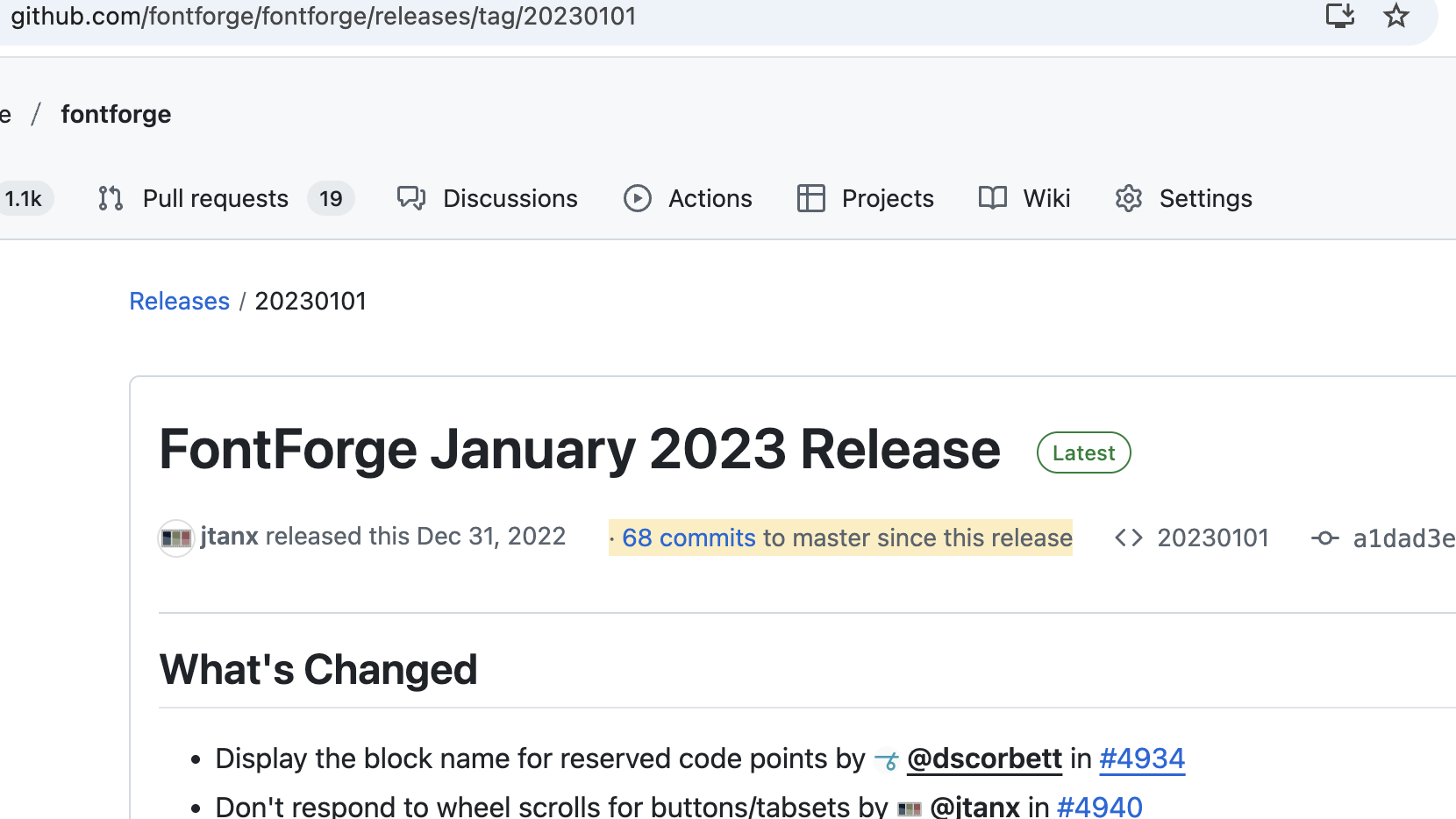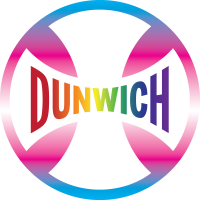Which is the best free font editor?
Comments
-
FontForge is great overall. If they could simplify the UI a bit, it would be the perfect free font editor.0
-
It depends on what you need. Fontforge is classic, but a bit dated and has lots of unsolved bugs due to its old code and few overburdened maintainers and does not support newer technologies like color fonts and variable fonts. Fontra is new, specially useful for creating variable font, but somewhat lacking in support for Opentype tables. Best is to use a combination. For example I create variable font in Fontra, add Opentype table in Fontforge, add color tables using adobe ot-svg, nanoemoji, Fonttools ttx, fontpainter etc, all of which are free, libre and useful in their own way.0
-
Depends a lot on your definition of “best,” and who the user is and what they need to do.
Font Forge: Reasonably usable and sorta complete-ish NOW. Even if it does have an interface only Linux users will be ok with. Not currently under active development, and (EDIT: has had some useful updates this year, although the rest of this sentence seems still true) seems unlikely to see major future updates (very old codebase super hard to update). No full built-in support for variable fonts or color fonts, though those can be done by using other tools in addition, I would call that less than ideal.
Fontra. Reasonably likely to be developed into the future. Good choice for teams and people doing variable fonts. But still needs some features.
Glyphr seems to be aimed specifically at beginners and non-professional users. This is fine, but obviously should not be expected to compete on features.
Birdfont I have not looked at enough to have a fully-informed opinion on.-1 -
When creating a professional font family, it’s crucial to use commercial software rather than relying on free tools. In my experience, commercial software like FontLab 8.4 stands head and shoulders above the rest, offering far superior efficiency and a wealth of advanced features. From OpenType support and precise kerning controls to powerful scripting capabilities, FontLab provides everything needed to create polished, production-ready fonts.1
-
On the one hand, many of the retail apps do offer features that the free apps do not. Often this includes usability/polish. And I use FontLab 8.4 myself, daily. It has many features that are not in any free tool as far as I know.
On the other hand, I wouldn’t say it is crucial to use retail, paid software. Some people have more time than money, and the tradeoffs may look different depending on your current situation. Or they have a dedication to libre tools.
Feedback probably isn’t relevant for FontForge, but for some other libre font editors under current development, usage and bug reports can help improve the app for the future. (This is also true for retail software, but they generally have enough users/feedback, and may even have paid testers.)1 -
Over the years, I have seen a bunch of free font tool projects start and wither, and others get to a reasonably stable release and then freeze and not get updated. A couple of recent projects are interesting—notably Fontra—, but it remains to be seen whether they’ll become useful and whether they’ll be maintained.
I agree with @Thomas Phinney that free font editors—in combination with today’s free font production libraries—are a viable option for someone who cannot afford a commercial tool and has the time to develop a workflow around free software. But that is because all font tools provide some basic, core functionality such as being able to edit outlines, set metrics, set name and other metadata entries, and, directly or indirectly, generate font binary files. The challenge for free font editors seems to be getting beyond that basic functionality.
For some — as, indeed, for one commercial font editor — the approach is to deliberately limit the scope of functionality provided in the out-of-the-box tool, and to shift responsibility for more extended functionality to a community of savvy users developing scripts and plugins. That’s great when such a community exists, but often one doesn’t emerge, and a tool simply languishes in a basic state without enough users to extend it.2 -
I offer a small correction to Thomas: While I would agree that Fontforge "seems unlikely to see major future updates", since working with its source code is laborious (more on that below), I want to point out that Fontforge is currently under active development, thanks mainly Maxim Iorsh (based in Israel) and Skef Iterum (based in California), and one can see the latest progress in https://github.com/fontforge/fontforge/commits/master/ which are pretty constant.
I also want to point out that there are four other libre font editor projects that I am aware of, that were not yet mentioned by name, and that I think are worth considering in this discussion; though I agree that "what is THE best???" is a odd question since it is "horses for courses"
I think its fair to say (and first please note, I don't speak for others in this, the following & below is my impressions based on chatting with them at the time, maybe mistaken) that all were started by FontForge 'refugees'. By that I mean contributors who eventually concluded it was 'hopeless' to develop FontForge in the C programming language, and that it was going to be much more fun and productive using a newer language and/or GUI framework despite starting from scratch.
1. https://github.com/trufont in Python, most similar to RoboFont in its conception, and on its 3rd start over (initially in PyQt and lately with wxWidgets), but not really updated since 2021; founded Adrien Tetar as a software engineering student who went on to become a product manager at Microsoft in Seattle.
2. https://github.com/linebender/runebender in Rust - I think perhaps the first font editor written the still novel Rust programming language. It has an even more rudimentary than Trufont in feature set, since it used zero 3rd party dependencies and truly did "start from scratch": The founder, computer scientist Raph Levien, started it as a vehicle for a whole new GUI framework in Rust, plus his PhD+ level research into splines; and that GUI framework project itself has been done over 3 times under the 'linebender' brand, and is a going concern, even though Runebender development ceased around 4 years ago.
3. https://github.com/MFEK in Rust, and its UI is even more peculiar than FontForge, flowing from the conceptions of the founder Fred Brennan - a fascinating character Fred was for a while the #1 contributor to Fontforge, but seeing Raph start Runebender 'from scratch', he was inspired to start 'not from scratch', using as many of the existing relevant libre software packages as possible. Sadly this has not been updated for about a year now, due Fred having some health issues due to his lifelong genetic condition.
Fred was for a while the #1 contributor to Fontforge, but seeing Raph start Runebender 'from scratch', he was inspired to start 'not from scratch', using as many of the existing relevant libre software packages as possible. Sadly this has not been updated for about a year now, due Fred having some health issues due to his lifelong genetic condition.
4. https://github.com/eliheuer/bezy is also in Rust, with Eli Heuer founding it due to the wind up of Runebender, where he initially had a fork of Runebender going as Spoonbender, and then took up the latest AI coding LLM technology, I think Bezy is also the 3rd start. This is very actively under development and I just heard from Eli that a v1.0 release might happen this year
BTW there have been very similar threads in the past that I remember, that you may find interesting.- https://typedrawers.com/discussion/1165/introducing-trufont-world-s-first-native-ufo3-font-editor-fully-cross-platform (big one)
- https://typedrawers.com/discussion/2255/trufont-as-a-complement-or
- https://typedrawers.com/discussion/1405/what-should-a-student-use
- https://typedrawers.com/discussion/4929/creating-a-font-editor
3 -
Every time I install Linux onto an older machine I want to resuscitate, I remember Mr. Hudson’s maxim, as I recall originally in the context of free fonts, but easily applicable to all free software: “When it’s free, it costs more.”3
-
I think that depends on your skills (and that on your interests and temperament), John
 Although the first libre software business made their slogan "making libre software affordable" haha
Although the first libre software business made their slogan "making libre software affordable" haha
0 -
To clarify once again: I truly appreciate that free software is available for type design. FontForge, in particular, offers a wide range of useful features. If you're creating a single font, it's entirely possible to achieve solid results using FontForge.
However, FontForge lacks the ability to design variable fonts and is generally less intuitive and user-friendly than commercial alternatives such as Glyphs 3.
Most professional type designers rely on commercial tools such as Glyphs 3, FontLab 8.4, or RoboFont. Personally, I prefer FontLab 8.4 because of its outstanding functionality—it provides everything needed for professional-level type design.
1 -
But, “Typedesigner,” the question wasn’t “what is the best font editor for professional type design,” but “of all the free font editors out there, which one is the best?”
At no point did OP say “I want to make a career in type design.” Nor even “I want to make variable fonts.”
And honestly, even if they did, it would still be reasonable for them to work with a libre font editor until either (1) some libre font editor matures enough to be a better choice for the work they want to do, or (2) they can afford proprietary tools and decide they are OK with that choice.
(Some people avoid proprietary software for reasons other than cost.)3 -
Thomas Phinney, it's difficult to give a detailed answer because we don't know what the questioner is trying to achieve with the free software. Are they aiming to design a single font or develop an extensive font family?
In my opinion, FontForge remains by far the most sophisticated and versatile free type design software available. Fontra — The browser-based Font Editor — is also considered an innovative piece of software. However, its range of features is still quite limited.1 -
On the plus side, there is a lot to type design that is independent of the particular tool you are using. Pick something and dive in, and you will be well ahead of not doing something — even if you change tools later.
For the long term (meaning several years from now), I suspect that Fontra may become a better place to be than FontForge.
BUT if one is going to do stuff and want to start today, and do not need serious built-in collaboration features or variable font support, FontForge is a fine choice.
3 -
I started creating fonts with Fontforge since 2020 and I am still using it to create fonts with it. When you get used to its UI, it is very easy to create Opentype features because you do not need to understand scripting for opentype. Just select feature, add input glyphs and desired output glyphs. And You are done with your feature. It can do really well with nested lookups where Fontlab can not do. BTW, these lookups will be broken when you open in Fontlab because you only can have one big feature and put all lookups in there. Therefore, it is very powerful and good enough for regular font creation. No color font or variable font supports, but I do not need them in my Windows Apps. I have big respect to the current and former developers of FontForge. They always check our questions & postings and gave asnwers or suggestions with them. And I can do svg import automation, automating creating anchor points, ligatures and many others in less than 2 minutes on over 150 glyphs. Good luck!!!1
-
It is also possible to create color fonts with fontforge using some planning and a workflow using additional libre software like ot-svg and nanoemoji. I have created a color emoji font and a color variable handwriting font using fontforge as the font editor and some shell script using the python libraries.
For professional type designers using proprietary tools, the design process is the fun. But for us non-designer, open source enthusiasts hacking such workflow is the fun part.
3 -
It can do really well with nested lookups where Fontlab can not do. BTW, these lookups will be broken when you open in Fontlab because you only can have one big feature and put all lookups in there.FontLab does fine with nested lookups—as does any other tool using AFDKO syntax coding—: you create and sort the lookups separately in the first part of the OTL code, and then associate them with features in the second part.
What you see when you crack open a binary font in FL is a decomposition and attempted parsing of the GSUB table, which doesn’t represent how the source for the table was originally coded. It tends to be simplified into feature blocks as you describe, but that doesn’t mean FL can’t handle nested lookups and other more complex structures.
[Funny to find myself defending an AFDKO-based OTL tool. I still to most of my OTL work in VOLT.]3 -
To be clear: I like free software and use lots of it. My favorite is Inkscape, which I prefer to Illustrator. I install Inkscape and Fontforge on every machine I touch. I use LibreOffice Writer and Calc instead of Word and Excel, because their OpenType support is far superior. Still no OT in Excel at all, and no access to the basic smcp feature inside Word. I’ve probably not spent a single cent on Adobe products for over fifteen years now. Ditto for Microsoft. I attempt to install Linux on something once a year or so, and I’ve succeeded a few times, but I’ve never been able to recover a corrupted Linux image.1
-
Hmm, John, in what sense then does Inkscape and LibreOffice cost you more than AI and MSo?0
-
Those don't. Trifling with Linux does.1
-
Personally, I'd say Fontlab 8 for its capabilities, or Fontself for its simplicity-2
-
Funny how things go around. Back in the day, you'd ask a question about commercial software and some well-meaning but annoying Linux guys would jump in and hijack the thread with free software recommendations. They thought they were trying to help, I suppose.3
-
In the context of the original subject, I suppose my answer would be beware your idea of “free.” I install Fontforge on everything, because it’s cheaper than buying another FontLab license, but yes, FontForge has now gone a few years with no updates. The thread did prompt me to install Fontra which indeed seems more promising in the latest version. It runs great on my 11-year-old Windows machine.0
-
https://github.com/fontforge/fontforge/releases/tag/20230101 is indeed the most recent 'release' from January 2023, but there's been 68 updates since then if you build from sourceJohn Butler said:FontForge has now gone a few years with no updates

I'll see if the active developers can make a new release 3
3 -
Ah, it having been two and a half years since the last dot release would be why I was thinking there hadn’t been any activity in a long time.
1 -
Oh, just build Fontforge from source, is that all. This is why normal people don’t use FOSS software.4
-
@James Puckett
To be fair, most more-active FLOSS projects not only offer pre-compiled downloadable versions, but update them more regularly.
Not that you are so very wrong, either; there are certainly differing expectations in the FOSS / libre software community.0 -
Normal people! lmao
The purpose of FOSS software isn't to be zero dollars, it is to give access to source code; therefore knowing how to compile source code is a reasonable expectation
0 -
It is a mismatch of expectations… but also a barrier to broader usage. But I guess in that theory, broad usage isn’t the point? Or, the projects that want broad usage can pre-compile the code for their users. The “problem” for those projects then is that because some FLOSS apps are hard to get set up, people tend to shy away from them.
(Anyhow, apologies for the thread drift. I will stop now.)0 -
Dave Crossland said:https://github.com/fontforge/fontforge/releases/tag/20230101 is indeed the most recent 'release' from January 2023, but there's been 68 updates since then if you build from source
it is not necessary to compile it yourself, because pre-compiled binaries of latest version fonforge for various platforms are available in Actions tab of its GitHub project to download. Probably Fontforge developers are waiting for elusive 'stable' stage, which, with backlog of more than a thousand issues spanning years, I don't think is possible.3 -
I would very much appreciate it if a new version of FontForge were released. The last official release is now more than two years old.
In my opinion, FontForge is currently missing two essential features that are highly important for type design:
-
Curve Tension (Tunni Lines) – crucial for controlling smoothness and proportions in curves.
-
A Transform Panel – including alignment buttons to position selected elements vertically or horizontally with precision.
It appears that implementing these features is not easy due to the outdated codebase. However, if successfully integrated, they would make FontForge significantly more practical, powerful, and user-friendly.
1 -
Categories
- All Categories
- 46 Introductions
- 3.9K Typeface Design
- 487 Type Design Critiques
- 564 Type Design Software
- 1.1K Type Design Technique & Theory
- 656 Type Business
- 861 Font Technology
- 29 Punchcutting
- 520 Typography
- 119 Type Education
- 324 Type History
- 77 Type Resources
- 112 Lettering and Calligraphy
- 33 Lettering Critiques
- 79 Lettering Technique & Theory
- 558 Announcements
- 94 Events
- 114 Job Postings
- 170 Type Releases
- 179 Miscellaneous News
- 276 About TypeDrawers
- 54 TypeDrawers Announcements
- 120 Suggestions and Bug Reports






